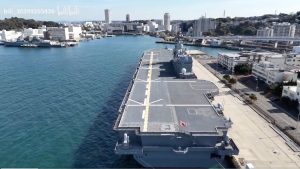On May 9, the Japanese Ministry of Defense announced it has found that a video posted on social media that claimed to have been shot by a Chinese drone flying over the JS Izumo is highly likely to be authentic.
The ministry said that after comprehensively analyzing the video’s footage of the vessel – Japan’s largest warship since World War II – nearby buildings, plants, waves, and shadows caused by sunlight and so on, it has determined the possibility of fabrication is very low.
The 19-second video and accompanying photos of the JS Izumo were uploaded to Chinese video-sharing platform BiliBili on March 26 by a user with a Chinese name. The poster claimed the footage had been recorded by drone at the Japan Maritime Self-Defense Force (JMSDF) Yokosuka Base in Kanagawa Prefecture, south of Tokyo. Yokosuka Base is also home to the U.S. Navy’s 7th Fleet.
The footage has since been taken down from BiliBili, but it has been reposted on other social media platforms such as X, formerly known as Twitter.
The drone appears to have approached the vessel from the rear and flown over the deck.
In Japan, flying a drone over Self-Defense Force facilities and their surrounding areas, such as Yokosuka Base, is prohibited by law. Those who violate the law are subject to imprisonment for up to one year or a fine of up to 500,000 yen ($3,215).
The Defense Ministry has been analyzing the video to determine if it was faked or edited since late March, when the JMSDF learned about the footage.
At the press briefing held by the ministry on May 9, there were a number of questions from reporters about the oddity of only one digit of the Izumo’s ship number appearing on the poop deck, instead of the full number, 83. Some experts had pointed to the discrepancy as evidence that the video was a fake.
The defense official said that the ship number, which was originally painted in white, had been painted in gray since fiscal year 2019. Thus, due to various technical factors such as light reflection and the viewing angle, only a portion of the ship number can be seen now, the official said.
“After carefully examining each of these points, we determined that there was basically no unnaturalness in the footage,” the official stressed.
This time, the drone just took video footage. No damage to the Izumo or other assets of the Defense Ministry and the JMSDF at Yokosuka has been reported. However, if the enemy’s purpose had been a surprise attack by drones, Tokyo might have found itself in a very serious situation, potentially losing one of the service’s two Izumo-class ships, the largest vessels in the fleet.
The Izumo and its sister ship, the Kaga, both officially helicopter-carrying destroyers, have been retrofitted into light aircraft carriers to accommodate F-35B fighters. The F-35B fighters have a vertical or short take-off capability and can be launched from short flight decks without the assistance of catapult systems.
The ministry said, “The Ministry of Defense and the Self-Defense Forces are taking the analysis results extremely seriously, as it could pose a serious hindrance to the defense of our country if defense-related facilities are harmed by drones.”
“Now that drone-related technology is developing rapidly, it is important to constantly improve base security capabilities,” it said.
“We intend to ensure base security through initiatives such as the early introduction of more capable drone countermeasure equipment and thorough measures to take strict and prompt measures within the scope of the law, such as forcing the landing of illegal drones by jamming radio waves,” the ministry added.
Previously, Japanese Defense Minister Kihara Minoru said at a press conference on April 2 that the video could be fake.
“We are analyzing the video, including the possibility that it was processed or fabricated with malicious intent,” Kihara told the news conference at that time. “We strictly monitor [drone activities around Yokosuka Base] on a regular basis,” he also said, adding “we will continue to work closely with related organizations to ensure base security.”
The user, who claims to have uploaded the video of JS Izumo to Chinese social media, had posted multiple photos of the Yokosuka-based USS Ronald Reagan, the U.S. Navy’s sole forward-deployed aircraft carrier, also apparently taken by a drone.
On May 9, Japanese defense officials avoided making a comment on the footage of the U.S. aircraft carrier, explaining that it occurred “in U.S. military facility areas outside of Japan’s jurisdiction.”
In any case, Tokyo needs to take all possible measures to secure its bases, including quickly equipping the country with advanced capabilities to detect, identify, and shoot down dangerous drones, and greatly increase its deterrence.

































